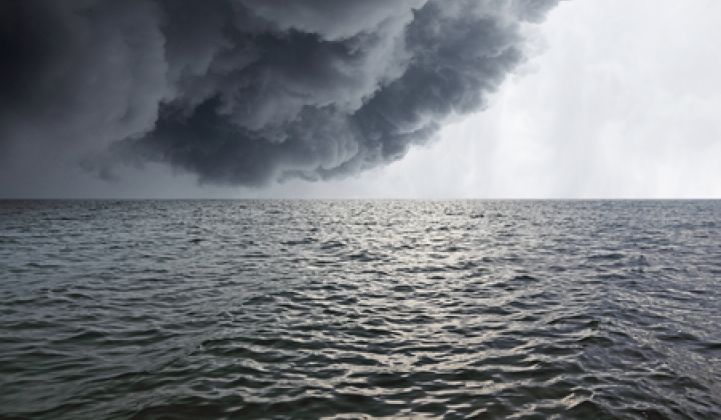Read this headline from the BBC and try to guess what year the story was written: "Tidal Power Generator Unveiling Hailed as a Landmark."
Or this one from Forbes: "Tidal Energy Could Be Next Big Wave."
No, they're not from 2006, when dozens of startups searching for money were boldly proclaiming how the waves and tides would be the next big thing in energy. They're from today, when we've seen virtually none of those claims have come true.
Nearly a decade after the surge of attention in marine energy technologies, the industry has not been able to overcome severe technical and financial challenges. As a result, installations have remained at pilot scale, while financing has been largely limited to government programs for testing and demonstrations.
And new projections from Bloomberg New Energy Finance (BNEF) show that the market for marine energy will be inconsequential for years to come.
According to BNEF, tidal power installations are expected to hit 148 megawatts by 2020, down 11 percent from forecasts made just a year ago. Wave power will be even smaller, with global capacity expected to reach 21 megawatts by the end of the decade -- a 72 percent downward revision from earlier forecasts.
To put that in perspective: SolarCity is installing more solar PV every seventeen days in America than the entire global installed base of wave power through 2020.
The promise of the technology is alluring. The International Energy Agency estimates that wave resources could theoretically provide 29,500 terawatt-hours per year, and tidal could produce more than 1,200 terawatt-hours per year. That's a little bit more than the total primary energy use of the U.S.
But the commercial deployments promised over the last ten years have largely failed to materialize. Between 2007 and 2010, numerous "landmark" projects were scrapped due to faulty equipment and high costs.
In 2009, after its AquaBuOY sank off the Oregon coast, Finavera Renewables decided to exit the market completely and focus on wind. That same year, Pelamis Wave Power removed the world's biggest wave project off the coast of Portugal due to technical issues, eventually abandoning the project after investors pulled back in the midst of the financial crisis. Pelamis is still working on its snake-like machine at a testing facility in Scotland, recently hitting 10,000 hours of operation, but it hasn't been able to build another commercial-scale project.
Numerous others have faced similar fates. After fourteen years and $30 million in investment, Verdant Power still hasn't built its hydrokinetic project in the East River. A few years ago, PG&E had to indefinitely suspend its wave energy testing program because of costs. And in July, Ocean Power Technologies canceled a "commercially unviable" 62-megawatt wave project off the coast of Australia.
This year has also brought a bankruptcy to one developer and further commercial project delays.
"Caution is necessary because taking devices from the small-scale demonstrator stage to the pre-commercial array stage is proving even more expensive and time-consuming than many companies -- and their investors - expected," said BNEF Senior Analyst Angus McCrone in a statement upon release of the new projections.
Numerous industrial heavyweights like Alstom, Lockheed Martin and Siemens have pursued investment opportunities in marine renewables. But Siemens' 1.2-megawatt tidal stream turbine, called SeaGen, is one of the only operational success stories among the three.
The struggles in marine energy are somewhat similar to those in concentrating solar power (CSP). Although the generation potential is theoretically very large, the capital costs and supply chain constraints are often prohibitive. Getting big industrial firms involved is certainly necessary in order to address these challenges; however, it doesn't guarantee they can make the business work. In recent years, most of the heavy-hitters in large power plant development have abandoned their involvement in CSP.
Marine renewables have an added challenge in that they're being deployed in the harshest environments in the world, creating expensive operational challenges.
Michael Liebreich, BNEF's chairman, described why those challenges make a future boom in marine renewables far from assured: "It is possible to make equipment reliable, as the offshore oil and gas industry has shown, but it’s not cheap. And you have to put a huge amount of steel and concrete into the water, which is inherently expensive. It is still unclear whether this can be done at a cost competitive with offshore wind, let alone other clean energy generating technologies," he said.



